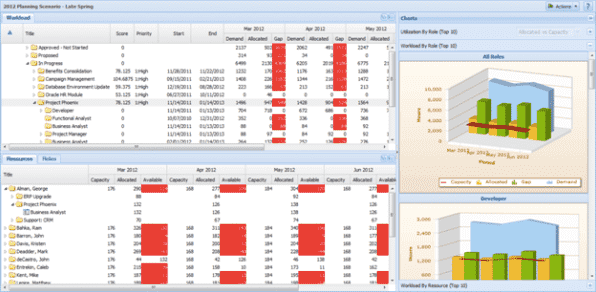And, we’re back with the exciting conclusion to our 3 part resource management blog series. We’ve already taken a look at laying a foundation and capturing our current workload. In this post, we will explore how we achieve optimization and alignment of our portfolio of projects to squeeze the most efficiency out of our people. Don’t worry – we won’t squeeze too hard.
Now, once we progress past just a current picture of our workload, things can get quickly out of hand. There are constant incoming requests for work, project managers that need their projects staffed, and of course we need to make sure that we are allocating people to projects appropriately (e.g. does this project really take 10 hours of a DBAs time?). We need to manage all this. Lucky for you, Innotas is at the ready.
We are going to take a look at a few areas:
- Managing Incoming Project Demand
- What-If Scenario Planning
- Capturing Actuals
We’ll keep this concise and to the point, so let’s dive in.
Managing Incoming Project Demand
Just because we’ve captured our current workload doesn’t mean we will never have more work come our way, but it does mean we can plan for it appropriately and set expectations with the requesting parties.
As new requests come our way, they will need to go through a proper approval process that includes a scoring component. Innotas provides request management functionality as well as configurable scoring profiles. We are not focusing on scoring here, but check out our eBook on Scoring and Prioritization for a lot of detail in this area. Scoring will help us maintain alignment with a generally accepted project scoring framework, helping us to pick up the right work for execution.
As these requests come in, in order to see how they will impact our resource pool, we need to capture role requirements. That includes:
- Role (project manager, business analyst, etc)
- Estimated Start and End Date for the Role
- Estimated Number of hours or headcount/FTE needed of each role
Innotas allows us to create these projects in a planning stage so that we can estimate needs for resources, and as we will see in the next section, understand what happens when those projects enter the fray.
What-If Planning
Now that we determined which projects to move forward with based on our scoring and prioritization framework and also captured role requirements for these proposed projects, we need to understand the impact they will have on our current workload. When can we take them on? Who is available to work on them? We don’t want to do this with the actual data because we’ll be playing with multiple scenarios. We need a workbench to play with this data and make sense of it.
Innotas provides a powerful What-If Workbench that allows you to do a few things:
- Exclude and Include Projects in the current portfolio
- Shift timelines of projects and the roles and resources assigned
- Assign Resources to projects
- View capacity and demand from a project, role, and resource perspective along with live updating charts
- Create multiple scenarios to provide us with options
Here it is in action:
The What-If workbench will allow us to optimize our resource pool against the demand for work now and into the future. It will help us plan out our roadmap of projects and help us understand the impact of incoming demand and the shifts that might need to take place in order to take on higher priority work.
This is fantastic so far. We’ve layed a foundation of our true capacity, stacked our current workload against it, and now we are managing incoming demand and reprioritizations. How can we get even better? Let’s take a look at capturing actuals.
Capturing Actuals
Thus far, we’ve only been looking at estimations of how much time work takes to get done. And while we are pretty good at making these estimations, we do want to get better at it. The only way we can do that is capture actual time against the work we’ve setup whether it be project or operational.
Innotas provides the ability to track time against all of the items we’ve setup thus far. So as we go forward, we can see how well we are estimating our projects and if we are a little off, correct those estimations to get an even better picture of our true capacity.
Conclusion
This wraps up our 3 part series on resource management. We hope that this has at least given you something to think about as you pursue your own resource management initiative.





